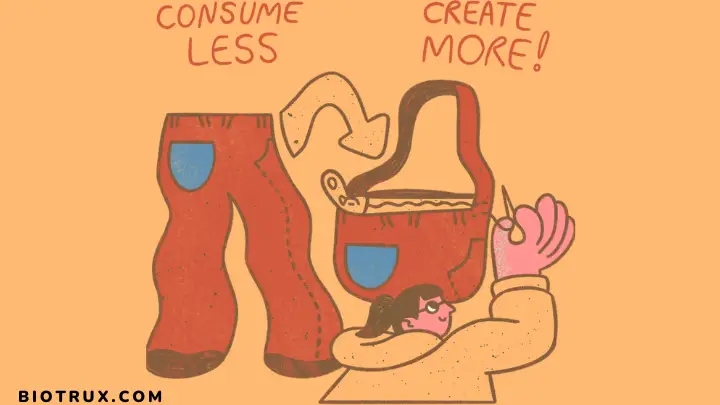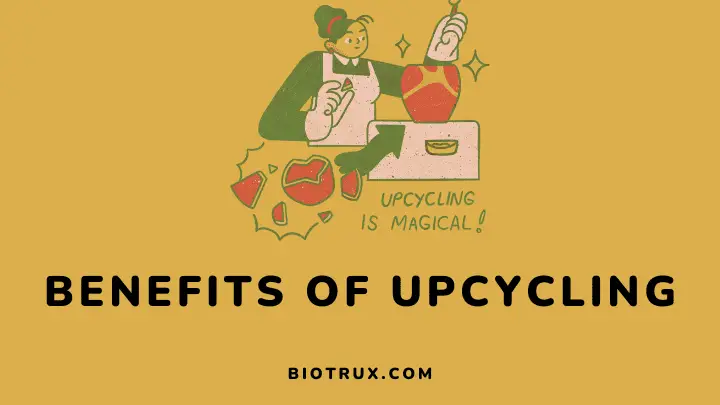In a world where waste is becoming a major issue, upcycling has become a trend worth exploring. Have you ever considered what you can do with all the unused things around your house or office? Upcycling is a suitable solution.
Not only is it beneficial for the environment, but it can also help you save money and unleash your inner creativity. This article will explore the many benefits of upcycling and why incorporating it into your lifestyle is great. Buckle up, and let’s dive in.
What is Upcycling?
Before diving into the benefits of upcycling, it’s imperative to explain what it is. Upcycling is a way of taking old, unused items and repurposing them into something new and functional.
Rather than throwing away clothing, furniture, or electronics, upcycling involves taking them apart and using the materials to create something valuable. Upcycling is a sustainable approach to reusing items that would otherwise end up in a landfill while offering a creative outlet and potential for profit.
By upcycling, you can create one-of-a-kind pieces that stand out in the marketplace and offer a personal touch that consumers are willing to pay for. Upcycling is a worthwhile option whether you are looking for an exciting hobby or a way to supplement your income.
It allows you to think outside the box and create something that reflects your style and personality.
The following are the benefits of recycling:
1. Environmental Conservation
Environmental conservation is a crucial aspect of upcycling because it reduces the number of new resources needed in production. By repurposing and reusing old materials, upcycling prevents the need for new resources to be extracted from the earth.
This can ultimately reduce the impact of resource extraction on ecosystems. Upcycling also helps reduce greenhouse gas emissions by decreasing the need for transportation and energy usage required to produce new goods.
Another important aspect of environmental conservation through upcycling is that it helps reduce the amount of pollutants released into the environment. When disposed of improperly, they can release toxins that harm the air, water, and soil.
By upcycling, we are preventing these toxins from being released and contributing to environmental degradation
2. Promoting Creativity and Innovation
Upcycling promotes creativity and innovation by encouraging individuals to think outside the box. It encourages them to develop creative ways to repurpose and reuse items that would otherwise be thrown away.
It requires creativity to turn an old sweater into a stylish scarf. In addition, it requires creativity to transform a discarded piece of furniture into a beautiful and functional piece for your home. Individuals are forced to think creatively and experiment with different materials, techniques, and designs by engaging in upcycling.
By embracing upcycling, you can develop a new skill set and flex your creative muscles. It can also inspire others to get involved and promote innovation in your community. You can generate new ideas and projects through upcycling by seeing potential in items that might otherwise go to waste.
3. Waste Reduction
Upcycling is a sustainable way of repurposing materials that would otherwise be discarded as waste. Upcycling reduces waste as materials are given a second life instead of being thrown away.
This reduces the amount of waste that reaches landfills, which are already overburdened with garbage. Upcycling also helps to reduce the environmental impact of waste disposal as the energy and materials required to produce new products are saved.
By upcycling, we can extend the lifespan of materials and reduce the amount of waste that ends up in landfill, ultimately reducing our carbon footprint and helping to protect the environment.
4. Community Engagement
One of the key benefits of upcycling is that it promotes community engagement. When you upcycle, you divert waste from landfills and contribute to your local economy by supporting small businesses and independent artists.
You can also involve your community in upcycling projects by hosting workshops or events. This is where people can learn about upcycling skills and create something unique and useful from items that would otherwise be discarded.
Through these activities, you can build connections with like-minded individuals and raise awareness about the importance of reducing waste. You can also inspire others to join in the effort to create a more sustainable future.
Overall, community engagement is a valuable benefit of upcycling that benefits the environment and helps build stronger, more connected communities.
5. Job Creation
Upcycling benefits the environment and helps create jobs in local communities. When people engage in upcycling activities, they create unique products with a higher value than regular waste items.
As a result, this leads to the development of a market for upcycled goods, which creates job opportunities. Moreover, upcycling often involves a lot of manual work, such as sorting, cleaning, and transforming old items into new ones.
This requires a skilled workforce to undertake the stages of upcycling, from collection to production and sales. In this way, upcycling can help employ a wide range of individuals, including those who are unskilled or have low levels of education.
In addition, upcycling can also create entrepreneurial opportunities for those who want to start their businesses. For example, someone could start a business of upcycling old clothes into new trendy fashion items.
6. Educational Value and Awareness
Upcycling provides an educational experience that goes beyond just repurposing items. It teaches people about sustainability, environmental impact, and creative problem-solving.
By learning about the value of reusing items, individuals become more aware of their consumption patterns and how their actions can impact the planet. This knowledge can be shared with others, inspiring them to adopt sustainable habits.
Upcycling also allows for hands-on learning, where individuals can experiment with different materials and techniques to create new and useful items. Overall, upcycling not only benefits the environment but also promotes a sense of awareness and responsibility for our actions.
7. Cost Saving
One of the most immediate benefits of upcycling is saving money. Upcycling allows you to repurpose items you own rather than purchasing new items or throwing out old ones.
This saves you money in the short term and helps you reduce your overall consumption, which can lead to significant cost savings over time. So if you’re looking for a way to save money while positively impacting the environment, upcycling is a great option.
Not only will you be doing your part to reduce waste and protect the planet, but you’ll also enjoy all the benefits of a more sustainable lifestyle.
8. Supporting Local and Rural Industry
Upcycling is a great way to support local and rural industries. By repurposing and giving new life to old items, you’re creating unique and sustainable products that are often one-of-a-kind.
This process typically involves sourcing materials from local thrift stores, flea markets, and garage sales, supporting local economies and small businesses. Upcycling is an excellent way to breathe new life into older products that may have been discarded.
This reduces the need for discarded items and the resources required to create them. So, if you’re looking to make a positive impact in your community and on the environment, consider upcycling as a way to support local and rural industries.
9. Reduction of Resource Extraction
By upcycling materials that might have otherwise ended up in landfills or oceans, we can reduce the amount of resources that need to be extracted from the earth. This, in turn, helps to preserve natural habitats, reduce energy consumption, and lower greenhouse gas emissions.
Upcycling also helps extend the lifespan of existing materials, which means fewer resources are required to create new products. All these factors contribute to a more sustainable future for our planet, and upcycling is a simple but effective way to do our part.
10. Personal Satisfaction
Upcycling, and transforming waste materials into new and useful products can positively impact personal satisfaction. Individuals can feel a sense of accomplishment and purpose by taking something that would otherwise be discarded and giving it new life.
Upcycling also allows individuals to express their creativity and uniqueness, as each upcycled item is typically one-of-a-kind. Furthermore, upcycling can be a financially rewarding hobby, as individuals can save money by repurposing items instead of buying new ones.
Overall, upcycling can contribute to a greater sense of personal satisfaction and fulfillment.

Are There Any Disadvantages of Upcycling?
While upcycling is generally viewed as an eco-friendly and creative way to repurpose materials, there are also some potential drawbacks to consider. Here are five potential disadvantages of upcycling:
1. Limited availability of materials: Finding the right materials may take time, depending on what you want to upcycle. If you’re looking for specific items like vintage fabrics or reclaimed wood, you may need to spend a lot of time and effort sourcing them.
2. Time-consuming process: Upcycling can be time-consuming, especially starting from scratch. Depending on the complexity of your project, you may need to spend hours cutting, sanding, and painting before you even get to the actual upcycling part.
3. Skill level required: Some upcycling projects require advanced crafting or DIY skills. For example, If you’re uncomfortable using power tools or sewing machines, you may find that some projects are beyond your abilities.
4. Limited resale value: While some upcycling projects can be sold for a profit, others may have limited resale value. This is particularly true for one-of-a-kind or highly customized pieces that may appeal to a narrow audience.
5. Safety concerns: Depending on the materials you’re working with, there may be safety concerns to consider. For example, using old lead-based paint or working with rusty metal could harm your health. Always take proper precautions when upcycling, and be aware of potential risks.
FAQs
What is the difference between upcycling and recycling?
While upcycling and recycling contribute to waste reduction, they differ in their approaches. Recycling involves breaking down materials into their raw form and using them to create new products. Upcycling, however, focuses on transforming the existing item into something of higher value without breaking it down.
Can anyone participate in upcycling?
Yes. Upcycling is a practice that anyone can engage in. It requires minimal skills or extensive resources. With creativity and some basic tools, individuals can upcycle various materials and create unique items that suit their preferences.
Where can you find materials for upcycling?
Materials for upcycling can be found in various places. Thrift stores, flea markets, garage sales, and even your home can be treasure troves for upcycling projects. Keep an eye out for items that can be repurposed and give them a new life through upcycling.
Final Thoughts
Upcycling is more than just a fun hobby or a trendy buzzword; it’s a way of life that offers a myriad of benefits to both individuals and the environment. By upcycling, you can reduce waste, save money, unleash your creativity, and positively impact the world around you.
The possibilities are endless, from turning an old t-shirt into a tote bag to transforming a broken chair into a garden planter. So why not try upcycling today and see what amazing things you can create? Together, we can all contribute towards a more sustainable future, one upcycled project at a time.
You should also read about what would happen without recycling.
Thanks for reading.

